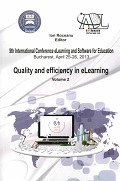DATA MINING SOLUTIONS FOR DETERMINING STUDENT'S PROF
DATA MINING SOLUTIONS FOR DETERMINING STUDENT'S PROF
Author(s): Anca Andreescu, Adela Bâră, Iuliana Botha, Manole Velicanu, Alexandra FloreaSubject(s): Education
Published by: Carol I National Defence University Publishing House
Keywords: data mining; student’s profile; questionnaire; cluster; classification
Summary/Abstract: The importance of this article comes from the complex issue of determining the students’ profile in order to develop educational activities and to improve their technical or social skills. The paper presents our experimental results and methods used to determine students ‘profile based on questionnaires collected from our university. We applied different methods of data extraction and analysis in order to assess their comparative effectiveness for determining the profile of our students in order to enroll them in extra curriculum activities such as international competition, internships, research and development. We consider the data mining techniques to be more efficient and thus we applied several techniques, supervised and unsupervised learning algorithms. We consider very useful to determine the profile for each student and also to group them in clusters. Based on questionnaires we extract and load data into a database and build the data mining models that function for construction, implementation, testing and manipulation of data. These models are based on a series of algorithms for classification, prediction, regression, clustering, association, selection and data analysis. The results are relevant; we manage to obtain an accuracy of 95% in several models. Therefore, the subject of students’ profile is a major research area due to its effect. In this research various attribute selection and data mining techniques have been used to build a few predictive models for this subject. It has been found that Logistic Regression performs very well, followed closely by the Support Vector Machines. Further work is under progress to apply the results in terms of clustering and developing new educational programs based on this clusters.
Journal: Conference proceedings of »eLearning and Software for Education« (eLSE)
- Issue Year: 9/2013
- Issue No: 02
- Page Range: 284-289
- Page Count: 6
- Language: English

